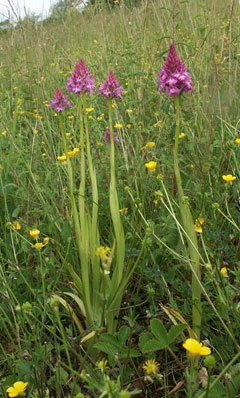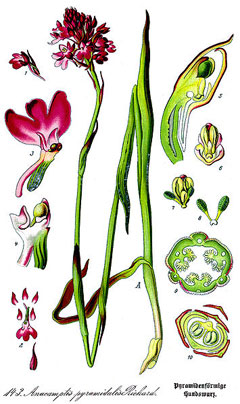 |
|
http://commons.wikimedia.org/wiki/User:BerndH |
 |
| http://commons.wikimedia.org/wiki/File:Illustration_Anacamptis_pyramidalis_clean.jpg |
Translate this page:
Summary
Physical Characteristics

 Anacamptis pyramidalis is a PERENNIAL growing to 0.3 m (1ft).
Anacamptis pyramidalis is a PERENNIAL growing to 0.3 m (1ft).
See above for USDA hardiness. It is hardy to UK zone 6. It is in flower from April to June, and the seeds ripen in July. The species is hermaphrodite (has both male and female organs) and is pollinated by Lepidoptera (Moths & Butterflies).
Suitable for: light (sandy), medium (loamy) and heavy (clay) soils and prefers well-drained soil. Suitable pH: neutral and basic (mildly alkaline) soils and can grow in very alkaline soils.
It cannot grow in the shade. It prefers dry or moist soil.
UK Hardiness Map
US Hardiness Map
Synonyms
Orchis pyramidalis.
Plant Habitats
Meadow;
Edible Uses
Edible Parts: Root
Edible Uses: Drink
Tuber - cooked[2, 4, 61]. It is a source of 'salep', a fine white to yellowish-white powder that is obtained by drying the tuber and grinding it into a powder[2, 105, 177]. Salep is a starch-like substance with a sweetish taste and a faint somewhat unpleasant smell[4]. It is said to be very nutritious and is made into a drink or can be added to cereals and used in making bread etc[5, 100, 183]. One ounce of salep is said to be enough to sustain a person for a day[100, 115].
References More on Edible Uses
Medicinal Uses
Plants For A Future can not take any responsibility for any adverse effects from the use of plants. Always seek advice from a professional before using a plant medicinally.
Demulcent Nutritive
Salep (see above for more details) is very nutritive and demulcent[4]. It has been used as a diet of special value for children and convalescents, being boiled with water, flavoured and prepared in the same way as arrowroot[4]. Rich in mucilage, it forms a soothing and demulcent jelly that is used in the treatment of irritations of the gastro-intestinal canal[4]. One part of salep to fifty parts of water is sufficient to make a jelly[4]. The tuber, from which salep is prepared, should be harvested as the plant dies down after flowering and setting seed[4].
References More on Medicinal Uses
The Bookshop: Edible Plant Books
Our Latest books on Perennial Plants For Food Forests and Permaculture Gardens in paperback or digital formats.

Edible Tropical Plants
Food Forest Plants for Hotter Conditions: 250+ Plants For Tropical Food Forests & Permaculture Gardens.
More

Edible Temperate Plants
Plants for Your Food Forest: 500 Plants for Temperate Food Forests & Permaculture Gardens.
More

More Books
PFAF have eight books available in paperback and digital formats. Browse the shop for more information.
Shop Now
Other Uses
References More on Other Uses
Cultivation details
Requires a deep rich soil[1, 135]. Prefers a hot well-drained bank[42], growing well in a sunny dry border or on a scree[230]. Orchids are, in general, shallow-rooting plants of well-drained low-fertility soils. Their symbiotic relationship with a fungus in the soil allows them to obtain sufficient nutrients and be able to compete successfully with other plants. They are very sensitive to the addition of fertilizers or fungicides since these can harm the symbiotic fungus and thus kill the orchid[230]. Plants can be grown in lawns in calcareous soils, they should not be cut down until the leaves are dying down in the summer[230]. During the day the flowers have a pronounced aroma of vanilla in order to attract pollinating butterflies. In the evening, when damp with dew, the smell is more goat-like and this acts as a repellent to moths[245].
References Carbon Farming Information and Carbon Sequestration Information
Temperature Converter
Type a value in the Celsius field to convert the value to Fahrenheit:
Fahrenheit:
The PFAF Bookshop
Plants For A Future have a number of books available in paperback and digital form. Book titles include Edible Plants, Edible Perennials, Edible Trees,Edible Shrubs, Woodland Gardening, and Temperate Food Forest Plants. Our new book is Food Forest Plants For Hotter Conditions (Tropical and Sub-Tropical).
Shop Now
Plant Propagation
Seed - surface sow, preferably as soon as it is ripe, in the greenhouse and do not allow the compost to dry out. The seed of this species is extremely simple, it has a minute embryo surrounded by a single layer of protective cells. It contains very little food reserves and depends upon a symbiotic relationship with a species of soil-dwelling fungus. The fungal hyphae invade the seed and enter the cells of the embryo. The orchid soon begins to digest the fungal tissue and this acts as a food supply for the plant until it is able to obtain nutrients from decaying material in the soil[200]. It is best to use some of the soil that is growing around established plants in order to introduce the fungus, or to sow the seed around a plant of the same species and allow the seedlings to grow on until they are large enough to move. Division of the tubers as the flowers fade[230]. This species produces a new tuber towards the end of its growing season. If this is removed from the plant as its flowers are fading, the shock to the plant can stimulate new tubers to be formed. The tuber should be treated as being dormant, whilst the remaining plant should be encouraged to continue in growth in order to give it time to produce new tubers[230]. Division can also be carried out when the plant has a fully developed rosette of leaves but before it comes into flower[230]. The entire new growth is removed from the old tuber from which it has arisen and is potted up, the cut being made towards the bottom of the stem but leaving one or two roots still attached to the old tuber. This can often be done without digging up the plant. The old tuber should develop one or two new growths, whilst the new rosette should continue in growth and flower normally[230].
Other Names
If available other names are mentioned here
Native Range
Coming Soon
Weed Potential
Right plant wrong place. We are currently updating this section.
Please note that a plant may be invasive in one area but may not in your area so it's worth checking.
Conservation Status
IUCN Red List of Threatened Plants Status :

Growth: S = slow M = medium F = fast. Soil: L = light (sandy) M = medium H = heavy (clay). pH: A = acid N = neutral B = basic (alkaline). Shade: F = full shade S = semi-shade N = no shade. Moisture: D = dry M = Moist We = wet Wa = water.
Now available:
Food Forest Plants for Mediterranean Conditions
350+ Perennial Plants For Mediterranean and Drier Food Forests and Permaculture Gardens.
[Paperback and eBook]
This is the third in Plants For A Future's series of plant guides for food forests tailored to
specific climate zones. Following volumes on temperate and tropical ecosystems, this book focuses
on species suited to Mediterranean conditions—regions with hot, dry summers and cool, wet winters,
often facing the added challenge of climate change.
Read More
Expert comment
Author
(L.)Rich.
Botanical References
17200
Links / References
For a list of references used on this page please go here
Readers comment